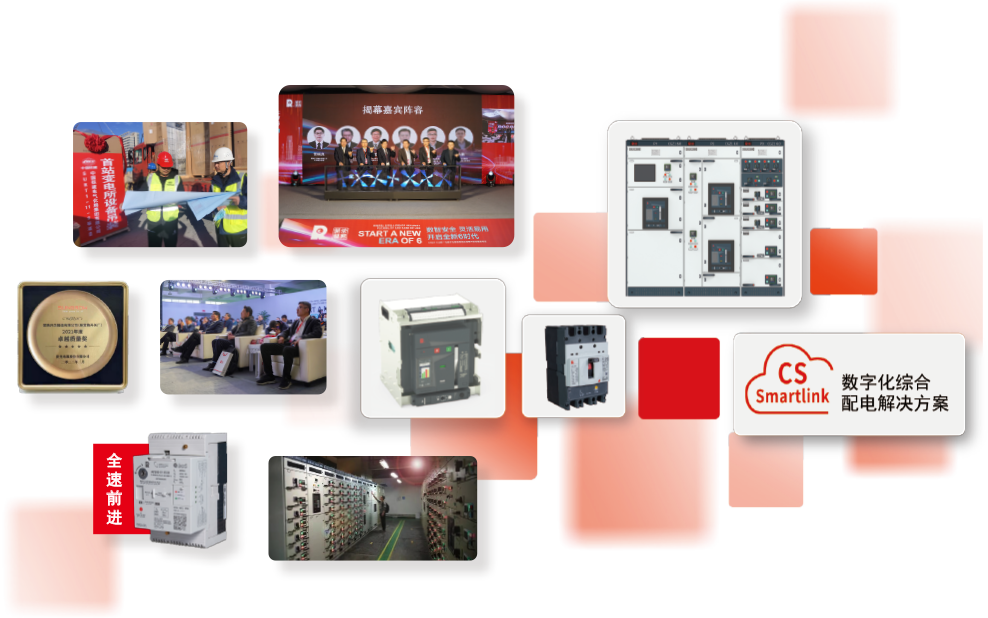CM6 Series Moulded Case Circuit Breakers
| Item number | Description of the fault situation | Possible causes | Troubleshooting |
| 1 | Circuit breakers are used for motor protection, tripping during starting and starting failure. | 1) If the motor is started directly, the starting current is at least 8 times the normal running current, or even up to 10 times more. If the rated current and the instantaneous protection current are not properly set, the motor will trip during the starting process and cannot complete the starting. | 1) whether the load carried is a direct motor start and what the starting current is; |
| 2) Reasonably determine the rated current of the circuit breaker and the instantaneous protection action current multiplier. | |||
| 2) If the distribution cabinet is far away from the equipment and the line voltage drop is large, the terminal voltage of the motor will be lower than the rated voltage of the motor and the starting current will increase, causing tripping. | 1) Find out how much voltage is at the end of the motor (P=IUcosφ); | ||
| 2) Reasonably determine the rated current of the circuit breaker and the instantaneous protective action current multiplier. | |||
| 3) If the motor starts with a load, check whether the load is normal. If the mechanical part runs with blocking, noise and other phenomena, its poor operation will cause difficulty in starting, sudden increase in current value, too long starting time and cause tripping. In addition, such as pumps, conveyor belts and other equipment if starting with a load, the starting time is too long and tripping. | 1) Check the operation of the mechanical part of the motor (load); | ||
| 2) Reasonably determine the rated current of the circuit breaker and the instantaneous protection action current multiplier. | |||
| 2 | During operation, the circuit breaker sometimes trips. | 1) Overload tripping caused by unbalanced three-phase load. | 1) Find out if the three phase currents are relatively balanced. |
| 2) The cable or copper row selected for connection has too small a cross-section and is prone to heat up, making the circuit breaker trip. | 1) Identify the cross-section and length of the cable or copper row to be connected; | ||
| 2) Correct selection of the cross-section of the connecting cable or copper row according to the sample; | |||
| 3) Rational selection of the length of the connected cable or copper row. | |||
| 3) If the connection screw is not tightened or poor contact causes contact resistance to rise, a lot of heat or even burn fusion, so that the circuit breaker trips. | 1) ascertain whether the circuit breaker is reliably connected to the cable and copper row; | ||
| 2) Tighten the screws connecting the circuit breaker to the cable and copper row. | |||
| 4) For plug-in or pull-out installation, a loose connector with poor contact will cause serious heat generation and tripping. | 1) Identification of plug-in contact; | ||
| 2) Reliable connection of the connectors. | |||
| 3 |
A short circuit occurs during circuit breaker operation A crossover trip. There may be two types of situations as follows: 1) No tripping of the plastic case circuit breaker and tripping of the universal circuit breaker 2) The low-voltage circuit breaker (including plastic case circuit breaker and universal circuit breaker) does not trip and the high-voltage protection apparatus trips. |
Generally, the protective characteristics of each series-connected circuit breaker are not properly matched and no suitable safety time is available. The analysis should be based on knowledge of the line, including the length and cross-section of the connecting cable, the estimated short-circuit current, the estimated current through the main circuit of the circuit breaker and the time of occurrence of the short-circuit fault. | 1) Check the status of the circuit breaker on site, if there is no refusal to divide, the product should be judged as normal; |
| 2) test the characteristics to determine whether the circuit breaker is qualified or not; | |||
| 3) Reasonable choice of circuit breakers. |
CM3 Series Moulded Case Circuit Breakers
| Description of the fault situation | Possible causes | Troubleshooting |
| Circuit breaker for motor protection, tripping during starting, starting failure | (1) If the motor is started directly, the starting current is at least 8 times the normal running current, or even up to 10 times or more. If the rated current instantaneous protection current is not properly set, it will trip during the starting process and cannot complete the starting. |
1) Whether the load carried is a direct motor start and what the starting current is; 2) Reasonably determine the rated current of the circuit breaker and the instantaneous protection action current multiplier. |
| 2) If the distribution cabinet is far away from the equipment and the line voltage drop is large, the terminal voltage of the motor will be lower than the rated voltage of the motor and the starting current will increase, causing tripping. |
1) Identify how much voltage is at the end of the motor (P=IUcos Φ); 2) Reasonably determine the rated current of the circuit breaker and the instantaneous protection action current multiplier. |
|
| 3) If the motor starts with load, check whether the load is normal, such as the mechanical part running with blocking, noise and other phenomena, its poor operation will cause starting difficulties, sudden increase in current, too long starting time, causing tripping. In addition, such as water pump, conveyor belt and other equipment if starting with load, the starting time is too long and tripping. |
1) Check the operation of the mechanical part of the motor (load); 2) Reasonably determine the rated current of the circuit breaker and the instantaneous protection action current multiplier. |
|
| During operation, the circuit breaker sometimes trips. | 1) Overload tripping caused by unbalanced three-phase load | 1) Find out if the three phase currents are relatively balanced. |
| 2) The cable or copper row selected for connection has too small a cross-section and is prone to heat up, causing the circuit breaker to trip. |
1) Identify the cross-section and length of the connected cable or copper row; 2) Select the correct cross-section of the connected cable or copper row according to the sample; 3) Select the correct length of the connected cable or copper row. |
|
| 3) If the connection screw is not tightened or poor contact causes contact resistance to rise, a lot of heat or even burn fusion, so that the circuit breaker trips. |
1) Find out if the circuit breaker is reliably connected to the cable and copper row; 2) Tighten the screws connecting the circuit breaker to the cable and copper row. |
|
| 4) For plug-in or pull-out installation, a loose connector with poor contact will cause serious heat generation and tripping. |
1) Identify the plug-in contact; 2) Connect the plug-in reliably. |
|
|
A short-circuit crossover trip occurs during circuit breaker operation. There may be two types of situations as follows: 1) non-tripping of the moulded case circuit breaker and tripping of the universal circuit breaker; 2) low-voltage circuit breakers (including moulded-case circuit breakers and universal circuit breakers) do not trip and high-voltage protective appliances trip |
It is generally the case that the protective characteristics of each series-connected circuit breaker are not properly matched and there is no suitable safety event. The analysis should be carried out with knowledge of the line, including the length and cross-section of the link cable, the time of the short-circuit fault, etc. |
1) check the status of the circuit breaker on site, if there is no refusal to divide, the product should be judged as normal; 2) test the characteristics to determine whether the circuit breaker is qualified or not; 3) Reasonable choice of circuit breaker. |
CM3L Series with Residual Current Protection Moulded Case Circuit Breakers
| Description of the fault situation | Possible causes | Troubleshooting |
| Circuit breaker for motor protection, tripping during starting, starting failure | (1) If the motor is started directly, the starting current is at least 8 times the normal running current, or even up to 10 times or more. If the rated current instantaneous protection current is not properly set, it will trip during the starting process and cannot complete the starting. |
1) Whether the load carried is a direct motor start and what the starting current is; 2) Reasonably determine the rated current of the circuit breaker and the instantaneous protection action current multiplier. |
| 2) If the distribution cabinet is far away from the equipment and the line voltage drop is large, the terminal voltage of the motor will be lower than the rated voltage of the motor and the starting current will increase, causing tripping. |
1) Identify how much voltage is at the end of the motor (P=IUcos Φ); 2) Reasonably determine the rated current of the circuit breaker and the instantaneous protection action current multiplier. |
|
| 3) If the motor starts with load, check whether the load is normal, such as the mechanical part running with blocking, noise and other phenomena, its poor operation will cause starting difficulties, sudden increase in current, too long starting time, causing tripping. In addition, such as water pump, conveyor belt and other equipment if starting with load, the starting time is too long and tripping. |
1) Check the operation of the mechanical part of the motor (load); 2) Reasonably determine the rated current of the circuit breaker and the instantaneous protection action current multiplier. |
|
| During operation, the circuit breaker sometimes trips. | 1) Overload tripping caused by unbalanced three-phase load | 1) Find out if the three phase currents are relatively balanced. |
| 2) The cable or copper row selected for connection has too small a cross-section and is prone to heat up, causing the circuit breaker to trip. |
1) Identify what is the cross-section of the connected cable or copper row? What is the length? 2) Select the correct cross-section of the connected cable or copper row according to the sample. 3) Select the correct length of the connected cable or copper strip. |
|
| 3) If the connection screw is not tightened or poor contact causes contact resistance to rise, a lot of heat or even burn fusion, so that the circuit breaker trips. | 3) Find out if the connection between the circuit breaker and the cable and copper row is reliable 4) Tighten the connection screws between the circuit breaker and the cable and copper row. | |
| 4) When plugged in, if the connector is loose and has poor contact, it will heat up seriously and cause tripping |
1. Identify plug-in contact. 2. Connect the plug-in reliably. |
|
| Circuit breaker leakage tripped. | 1) The selected circuit breaker is a three-phase circuit breaker, while on the load side of the circuit breaker there is a single-phase load with neutral line or the existence of the control circuit, resulting in the load side current vector and greater than the residual current rectification value, causing tripping. | 1. Selection of four-pole circuit breakers |
| 2) The total residual current in the system exceeds the residual current setting value. | 2. Correctly set residual current protection values | |
| 3) The circuit breaker residual current protection operates faster than the lower level with residual current protection circuit breaker. | 3. Use time delay type circuit breaker | |
|
A short-circuit crossover trip occurs during circuit breaker operation. There may be two types of situations as follows: 1) non-tripping of the moulded case circuit breaker and tripping of the universal circuit breaker; 2) low-voltage circuit breakers (including moulded-case circuit breakers and universal circuit breakers) do not trip and high-voltage protective appliances trip |
It is generally the case that the protective characteristics of each series-connected circuit breaker are not properly matched and there is no suitable safety event. The analysis should be carried out with knowledge of the line, including the length and cross-section of the link cable, the time of the short-circuit fault, etc. |
1. check the status of the circuit breaker on site, if there is no refusal to divide, the product should be judged as normal; and 2. test the characteristics to determine whether the circuit breaker is qualified or not; 3. Reasonable selection of circuit breakers. |
CM3ZL Series with Residual Current Protection Intelligent Moulded Case Circuit Breakers
| Description of the fault situation | Possible causes | Troubleshooting |
| Circuit breaker for motor protection, tripping during starting, starting failure | (1) If the motor is started directly, the starting current is at least 8 times the normal running current, or even up to 10 times or more. If the rated current instantaneous protection current is not properly set, it will trip during the starting process and cannot complete the starting. |
1) Whether the load carried is a direct motor start and what the starting current is; 2) Reasonably determine the rated current of the circuit breaker and the instantaneous protection action current multiplier. |
| 2) If the distribution cabinet is far away from the equipment and the line voltage drop is large, the terminal voltage of the motor will be lower than the rated voltage of the motor and the starting current will increase, causing tripping. |
1) Identify how much voltage is at the end of the motor (P=IUcos Φ); 2) Reasonably determine the rated current of the circuit breaker and the instantaneous protection action current multiplier. |
|
| 3) If the motor starts with load, check whether the load is normal, such as the mechanical part running with blocking, noise and other phenomena, its poor operation will cause starting difficulties, sudden increase in current, too long starting time, causing tripping. In addition, such as water pump, conveyor belt and other equipment if starting with load, the starting time is too long and tripping. |
1) Check the operation of the mechanical part of the motor (load); 2) Reasonably determine the rated current of the circuit breaker and the instantaneous protection action current multiplier. |
|
| During operation, the circuit breaker sometimes trips. | 1) The total residual current in the system exceeds the residual current setting value | 1) Set the residual current protection value correctly. |
| 2) Field equipment with poorly insulated conductors, resulting in line leakage faults. | (1) Timely inspection of aged wiring and equipment to eliminate safety hazards. | |
| 3) The circuit breaker residual current protection operates faster than the lower level with residual current protection circuit breaker. | 1) Set the residual current protection delay time correctly. | |
|
A short-circuit crossover trip occurs during circuit breaker operation. There may be two types of situations as follows: 1) non-tripping of the moulded case circuit breaker and tripping of the universal circuit breaker; 2) low-voltage circuit breakers (including moulded-case circuit breakers and universal circuit breakers) do not trip and high-voltage protective appliances trip |
It is generally the case that the protective characteristics of each series-connected circuit breaker are not properly matched and there is no suitable safety event. The analysis should be carried out with knowledge of the line, including the length and cross-section of the link cable, the time of the short-circuit fault, etc. |
1. check the status of the circuit breaker on site, if there is no refusal to divide, the product should be judged as normal; and 2. test the characteristics to determine whether the circuit breaker is qualified or not; 3. Reasonable selection of circuit breakers. |
| Irregular communication | 1) No communication power supply. | Ensure proper power supply to the main circuit. |
| 2) The communication wiring is incorrect or has been broken. | Check the communication cable to ensure correct wiring. | |
| 3) Bad RS485/RS232 conversion adapter. | Replace the converter. | |
| 4) Too many devices connected and poor driveability. | Add matching resistors and pull-up resistors to the terminals. |
CM3ZL/ZH Series Automatic Reclosing with Residual Current Protection Moulded Case Circuit Breakers
| Description of the fault situation | Possible causes | Troubleshooting |
| Circuit breaker for motor protection, tripping during starting, starting failure | (1) If the motor is started directly, the starting current is at least 8 times the normal running current, or even up to 10 times or more. If the rated current instantaneous protection current is not properly set, it will trip during the starting process and cannot complete the starting. |
1) Whether the load carried is a direct motor start and what the starting current is; 2) Reasonably determine the rated current of the circuit breaker and the instantaneous protection action current multiplier. |
| 2) If the distribution cabinet is far away from the equipment and the line voltage drop is large, the terminal voltage of the motor will be lower than the rated voltage of the motor and the starting current will increase, causing tripping. |
1) Identify how much voltage is at the end of the motor (P=IUcos Φ); 2) Reasonably determine the rated current of the circuit breaker and the instantaneous protection action current multiplier. |
|
| 3) If the motor starts with load, check whether the load is normal, such as the mechanical part running with blocking, noise and other phenomena, its poor operation will cause starting difficulties, sudden increase in current, too long starting time, causing tripping. In addition, such as water pump, conveyor belt and other equipment if starting with load, the starting time is too long and tripping. |
1) Check the operation of the mechanical part of the motor (load); 2) Reasonably determine the rated current of the circuit breaker and the instantaneous protection action current multiplier. |
|
| During operation, the circuit breaker sometimes trips. | 1) The total residual current in the system exceeds the residual current setting value | 1) Set the residual current protection value correctly. |
| 2) Field equipment with poorly insulated conductors, resulting in line leakage faults. | (1) Timely inspection of aged wiring and equipment to eliminate safety hazards. | |
| 3) The circuit breaker residual current protection operates faster than the lower level with residual current protection circuit breaker. | 1) Set the residual current protection delay time correctly. | |
| A short-circuit crossover trip occurs during circuit breaker operation. There may be the following two types of situations: 1) no tripping of plastic case circuit breakers and tripping of universal circuit breakers; 2) no tripping of low-voltage circuit breakers (including plastic case circuit breakers and universal circuit breakers) and tripping of high-voltage protective appliances | It is generally the case that the protective characteristics of each series-connected circuit breaker are not properly matched and there is no suitable safety event. The analysis should be carried out with knowledge of the line, including the length and cross-section of the link cable, the time of the short-circuit fault, etc. |
1. check the status of the circuit breaker on site, if there is no refusal to divide, the product should be judged as normal; and 2. test the characteristics to determine whether the circuit breaker is qualified or not; 3. Reasonable selection of circuit breakers. |
| No breaking and closing of electric controls | 1) Incorrect electrical/manual position on the electric control. | Dial to the correct position |
| 2) No power supply for electric operation. | Ensure proper power supply to the main circuit. | |
| 3) No suitable voltage with undervoltage accessories | Make sure that the undervoltage accessory has the right voltage. | |
| Irregular communication | 1) No communication power supply. | Ensure proper power supply to the main circuit. |
| 2) The communication wiring is incorrect or has been broken. | Check the communication cable to ensure correct wiring. | |
| 3) Bad RS485/RS232 conversion adapter. | Replace the converter. | |
| 4) Too many devices connected and poor driveability. | Add matching resistors and pull-up resistors to the terminals. |
CM3E Series Electronic Moulded Case Circuit Breakers
| Description of the fault situation | Possible causes | Troubleshooting |
| Circuit breaker for motor protection, tripping during starting, starting failure | (1) If the motor is started directly, the starting current is at least 8 times the normal running current, or even up to 10 times or more. If the rated current instantaneous protection current is not properly set, it will trip during the starting process and cannot complete the starting. |
1) Whether the load carried is a direct motor start and what the starting current is; 2) Reasonably determine the rated current of the circuit breaker and the instantaneous protection action current multiplier. |
| 2) If the distribution cabinet is far away from the equipment and the line voltage drop is large, the terminal voltage of the motor will be lower than the rated voltage of the motor and the starting current will increase, causing tripping. |
1) Identify how much voltage is at the end of the motor (P=IUcos Φ); 2) Reasonably determine the rated current of the circuit breaker and the instantaneous protection action current multiplier. |
|
| 3) If the motor starts with load, check whether the load is normal, such as the mechanical part running with blocking, noise and other phenomena, its poor operation will cause starting difficulties, sudden increase in current, too long starting time, causing tripping. In addition, such as water pump, conveyor belt and other equipment if starting with load, the starting time is too long and tripping. |
1) Check the operation of the mechanical part of the motor (load); 2) Reasonably determine the rated current of the circuit breaker and the instantaneous protection action current multiplier. |
|
| During operation, the circuit breaker sometimes trips. | 1) Overload tripping caused by unbalanced three-phase load | 1) Find out if the three phase currents are relatively balanced. |
| 2) Site equipment is often overloaded for short periods of time, causing energy to accumulate and then trip after a certain amount of time. | Ensure that the circuit breaker is used under the rated range and that the circuit breaker adjustment value can be adjusted upwards as appropriate. | |
|
A short-circuit crossover trip occurs during circuit breaker operation. There may be two types of situations as follows: 1) non-tripping of the moulded case circuit breaker and tripping of the universal circuit breaker; 2) low-voltage circuit breakers (including moulded-case circuit breakers and universal circuit breakers) do not trip and high-voltage protective appliances trip |
It is generally the case that the protective characteristics of each series-connected circuit breaker are not properly matched and there is no suitable safety event. The analysis should be carried out with knowledge of the line, including the length and cross-section of the link cable, the time of the short-circuit fault, etc. |
1) check the status of the circuit breaker on site, if there is no refusal to divide, the product should be judged as normal; 2) test the characteristics to determine whether the circuit breaker is qualified or not; 3) Reasonable choice of circuit breaker. |
Contact information

WeChat Official Account

WeChat video

Tiktok
Copyright:Changshu swItchgear mfg.co.,ltd.(Former Changshu switchgear plant) 苏ICP备10211285号 Powery by:300.cn




 400-8282528
400-8282528


 cskg0001@cs-kg.com
cskg0001@cs-kg.com
